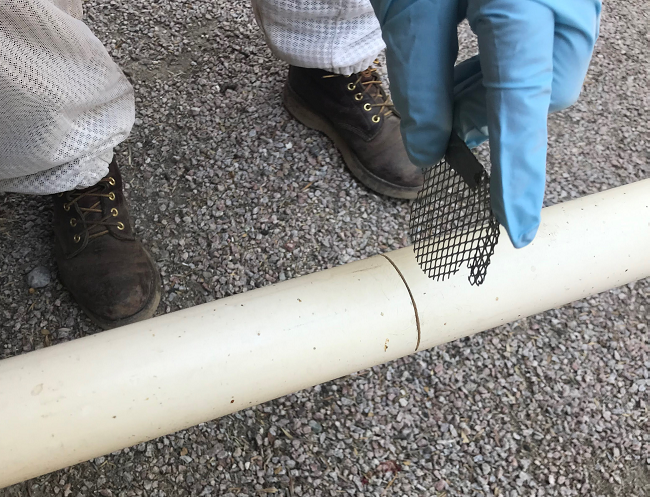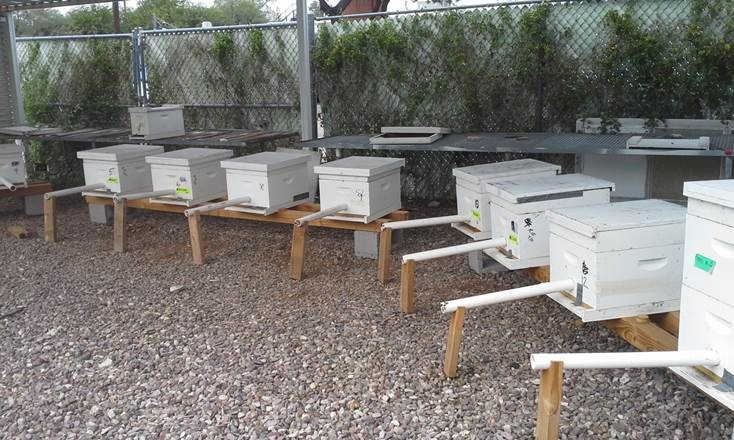Tracking and Measuring Mite Migration
To view the paper: Population growth of Varroa destructor (Acari:Varroidae) in honey bee colonies is affected by the number of foragers with mites click here.
Varroa mites are a serious pest of honey bees and the leading cause of colony losses. Varroa have relatively low reproductive rates, so populations should not increase rapidly, but often they do. In this study we explore the growth of varroa populations caused by mite migration into colonies on foragers from other hives. We discuss the rapid growth of mite populations particularly in the fall being a product of mite migration rather than mite reproduction only. One explanation for the rapid increase in mite numbers especially in the fall is that mites move among colonies by attaching to foragers.
We measured the proportion of foragers carrying mites on their bodies while entering and leaving hives, and determined its relationship to the growth of varroa populations in those hives. We also compared the estimates of mite population growth with predictions from a varroa population dynamics model that generates estimates of mite population growth based on mite reproduction.
Samples of capped brood and adult bees indicated that the proportion of brood cells infested with mites and adult bees with phoretic mites was low through the summer but increased sharply in the fall. The frequency of capturing foragers with mites on their bodies while entering or leaving hives also increased in the fall. The growth of varroa populations was related to the total number of foragers with mites (FWM) entering and leaving the colony.
Mites could attach to foragers when they rob weak colonies collapsing from high mite infestations. Drifting foragers carrying mites also could contribute to the movement of varroa among colonies. The combination of field data and simulations suggest that FWM were drifting in from other colonies and contributing to the growth of varroa populations in our colonies particularly in the fall.
Specialized entrance tubes placed in the colonies 
Screen is placed half way through the tube to separate incoming and outgoing foragers

Entrance is corked after 2 minutes to collect incoming foragers
Tube with dividing screen filled with foragers: outgoing on the left, incoming on the right
Bees from one end of the tube (incoming foragers) collected in alcohol

Dispersal Mechanisms of Varroa
To view the paper: Are Dispersal Mechanisms Changing the Host-Parasite Relationship and Increasing the Virulence of Varroa destructor (Mesostigmata: Varroidae) in Managed Honey Bee (Hymenoptera: Apidae) Colonies click here.
In this study we show the challenges of controlling varroa in commercial apiaries by reporting data collected from a longitudinal study that compared colony growth and survival with different numbers of miticide treatments throughout the year. We then describe dispersal mechanisms of varroa within the framework of a parasite that has shifted from survival in widely spaced feral honey bee colonies to managed apiaries with high concentrations of hives. We also discuss the association of the mite with honey bee viruses because they are a compounding factor in the devastation varroa causes in managed colonies. The varroa–virus association also might be a contributing factor in the mite dispersal mechanisms that are unique to managed apiaries.
The results from the longitudinal study reported here provide a glimpse of what varroa is doing to managed colonies. High fall mite numbers in our colonies that were lightly infested in the spring could have been from the dispersal of mites from colonies that had collapsed. September treatments could not save many of our colonies from perishing, indicating that the damage from the mites and virus infections could not be reversed with fall-only miticide treatments. The colonies we lost would themselves become a source of mites dispersing to other hives and adding to their overwinter varroa population.
To improve varroa control and increase colony survival especially over winter, integrated pest management (IPM) strategies need to be developed that treat varroa as a migratory pest. The strategies should incorporate fundamental components of IPM focusing on sustainable control methods that combine resistance management through the rotation of miticides, use of mite-resistant lines, and modifications in beekeeping practices.
The varroa mite that entered the United States in the 1990s and was kept at low levels in managed colonies with well-timed miticide treatments perhaps no longer exists. The mites and the viruses they transmit have become increasingly harmful to bees, and the collapse of colonies has been co-opted as a dispersal mechanism. However, this cycle of mite increase, colony weakening, and mite dispersal can be broken by adopting beekeeping practices and mite control strategies with broader sensibilities to the type of pest that varroa has become.
Can Varroa and Virus Levels be Reduced with Good Nutrition?
To read more about the study: Can Supplementary Pollen Feeding Reduce Varroa Mite and Virus Levels and Improve Honey Bee Colony Survival click here.
Varroa and the viruses they transmit are a major cause of colony losses worldwide. Nutritionally stressed colonies that are infested with Varroa often perish during the winter. Perhaps then, improving colony nutrition could increase the chances that colonies with Varroa will survive. To test this possibility, we measured Varroa populations and virus levels in colonies with and without supplemental pollen feeding from July to December. Colonies fed supplemental pollen had significantly larger populations than unfed colonies and had higher survival rates. However, feeding pollen did not affect levels of Varroa infestation or deformed wing virus (DWV). Varroa populations were similar between fed and unfed colonies, and were correlated with the frequency of capturing foragers with mites (FWM) at colony entrances. FWM were captured with similar frequency in fed and unfed colonies. DWV levels increased as Varroa populations grew in colonies with or without supplemental pollen feeding. While FWM also were carrying and spreading DWV, their levels were similar to those of nurse bees, and significantly lower than foragers without mites. These findings suggest that FWM might be of nurse bee age and are foraging precociously. If mites entering on foragers significantly increase Varroa and DWV levels, any advantages that supplemental pollen feeding have on improving immune function or reducing mite reproduction may be negated. However, pollen feeding might provide greater tolerance to Varroa and virus at both the individual and population levels through greater worker longevity and higher brood rearing rates.
